![]()
![]()
![]()
Use LEFT and RIGHT arrow keys to navigate between flashcards;
Use UP and DOWN arrow keys to flip the card;
H to show hint;
A reads text to speech;
24 Cards in this Set
- Front
- Back
- 3rd side (hint)
|
1) Which of the Cervical Vertebrae are typical?
|
C3-C6
|
|
|
|
What are the 5 features of typical cervical vertebrae?
|
1) Small body
2) Big triangle vertebral foramina 3) Short stubby transverse processes with posterior and anterior tubercles 4) Transverse foramina 5) Bifid spinous processes |
|
|
|
What is unique about C7 and any Vertebrae that are in a transitional portion of the vertebral column?
|
C7 is also called the vertebral prominence. As with any vertebra that lay in a transitional area, it has features of the vertebrae above and below it.
Its spinal process is not bifid and is larger than other cervical vertebrae. However, it still has a big vertebral foramina and transverse foramina. |
|
|
|
What are the 3 reasons the cervical spine have the greatest range of motion?
|
1) The orientation of the articular Facets.
2) The relative thickness of the intervertebral discs, which are wedge shape in the Cervical and Lumbar regions. 3) Small amount of surrounding body mass (soft tissue) |
3 Planes
1) Clavicular - Lateral Flexion (35 degrees) 2) Occlusal - Flexion (65 degrees) and Extension (40 degrees) 3) Sagittal - Rotation (50 degrees) 3) Sagittal |
|
|
What is the orientation of the cervical articular facets?
|
Oblique to the horizontal by about 30 -45 degrees?
|
|
|
|
What is the cost of the cervical regions range of motion?
|
The cost of the range of motion is stability and allows for z joint dislocation w/o accompanying veterbarl fracture from traumatic force.
|
|
|
|
What are some points of interest of the cervical spine?
|
1) The facets joint are stacked on each other forming an articular column.
2) Intervertebral are small and round, with their anterior margins formed by the intervertebral discs. There is no boney wall. ???? The transverse processes have a spinal nerve sulcus make. The Cervical region is the second most likely to have a disc herniation, which will impinge upon the nerve exiting at the intervertebral level. |
|
|
|
Where is the vertebral canal and the spinal cord the largest?
|
1) Cervical region
2) Lumbar region These are have larger vertebral canal to accommodate the amount of nerves need to control the extremities. |
|
|
|
What is the Ligamentum Nuchae (or Nuchal Ligementum)?
|
A bilaminar fibroelastic septum which runs from the external occipital
protuberance of the skull to the spinous process of the vertebra prominens Provides surface area for the attachment of posterior cervical (nuchal) musculature, which maintains head position and resists gravity in erect posture. It is attached to the bifid spinous processes. |
|
|
|
What travels through the transverse foramina of the cervical spine?
|
Vertebral Arteries and veins arise above the thorax travel through the transverse formina to the foramen magnum
|
|
|
|
What are Unicate Processes?
|
They are an epiphenomenon of disc degeneration that occur as the discs lose moisture and shrink. The spondylophytes (osteophytes) grow from the lateral superior aspect of the vertebrae.
|
|
|
|
What are the results of Unicate Process growth?
|
The vertebrae can make contact forming uncovertebral (new) joints leading to inflammation and bone growth. Starting at age 20!
It may lead to reduced cervical spine mobility or expand posteriorly to impinge upon the spinal cord in the vertebral canal. It can all grow laterally and impinge on spinal nerve roots or the vertebral arteries. This stenosis may reduce blood flow to the brain. |
|
|
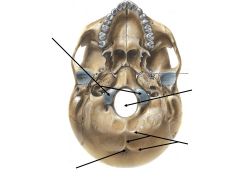
What are the labeled portions of the skull?
|
1) Foramen Magnum - Spinal cord descends from and vertebral arteries ascend into the cranial cavity
2) Nuchal Lines - Provide attachment for posterior cervical muscles the maintain head position and can reorient the sense organs in response to external stimuli 3) External Occipital Protuberance - The Trapezius and Nuchal Ligament attach here 4) Occipital Condyles - Biconvex* and rest of C1 (atlas) |
- Condyles are biconvex, which means they are shaped to allow movement on the Sagittal and Coronal plane movement. Other example are knees and knuckles
|
|
|
Which two cervical vertebrae are atypical?
|
C1- Atlas
C2 Axis |
|
|
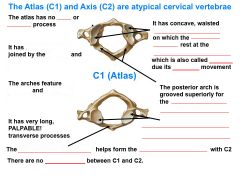
Atypical Cervical Vertebrae Slide
|

Answers
|
|
|
|
What are 3 features and 2 pathologies of the Atlanto-Occipital Joint?
|
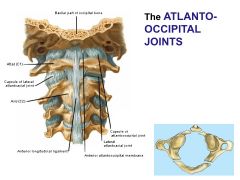
FEATURES
1) It is the "Yes Joint". 2) It is a Synovial joint*. 3) Very strong joint to hold head. PATHOLOGY 1) Jefferson Fracture - blows to the top of the head can fracture the anterior and posterior arches of the Atlas 2) Hoop Fracture - with enough force the foramen magnum can fracture. |
Synovial Joint is enclosed with a fibrous joint capsule, which surrounds the articular surfaces and forms a closed articular cavity. The cavity is lined with synovial membrane which secretes lubricating synovial fluid.
The articular surface are covered with distortable (hyaline ) cartilage laid over a thin layer of subchondral bone. |
|
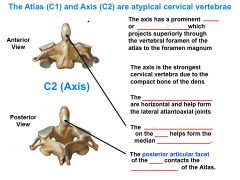
C2 Atypical Cervical Joint
|

Answers
|
|
|
|
What is a pathology of C2?
|
Hangman's Fracture - humane way to break the pedicle of the vertebral arch , which would disrupt cerebral and spinal arteries.
|
|
|
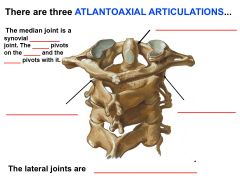
Name the 3 Atlantoaxial Joints and there types of joints.
|

Answers
|
|
|
|
The Atlantoaxial Joints are also called the _________ joints.
|
The NO joint.*
|
|
|
|
Where is the dens located?
What is the 1/3, 2/3 rule? |
The dens is in the anterior 1/3 and spinal cord takes up the posterior 2/3.
|
|
|
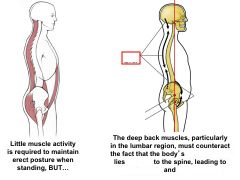
Explain the erect posture.
|

Answer
|
|
|
|
Explain the Flexion and Extension of the back
|
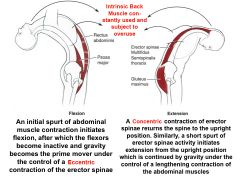
Answer
|
|
|

What is important about this slide?
|
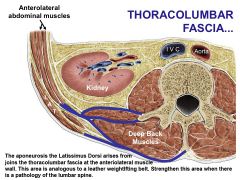
Answer
|
|

